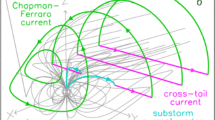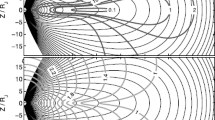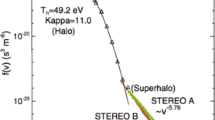Abstract
THE basic difficulty with the theories of pulsar radiation is that there is as yet no self-consistent model of the large scale structure of the plasma atmosphere of the pulsar1,2. The lack of such a model is perhaps most strikingly exemplified by the fact that there is no consistent explanation of how an aligned rotating magnetised neutron star can maintain a net zero current from its surface—that is, how either a finite current loop in its atmoshere, or an ‘infinite’ loop to the nebula, is established consistent with the space charge and the electromagnetic fields3,4. This letter will be limited to a discussion of how current loops are established when the rotational and magnetic axes are aligned.
Similar content being viewed by others
References
Ruderman, M., A. Rev. Astr. Astrophys., 10, 427 (1972).
Ginzburg, V. L., and Zheleznyakov, V. V., A. Rev. Astr. Astrophys., 13, (1975).
Goldreich, P., and Julian, W. H., Astrophys. J., 157, 869 (1969).
Okamoto, I., Mon. Not. R. astr. Soc., 167, 457 (1974); ibid., 170, 81 (1975).
Landau, L. D., and Lifshitz, E. M., The Classical Theory of Fields, 73 (Addison-Wesley, New York, 1962). There is a misprint.
Author information
Authors and Affiliations
Rights and permissions
About this article
Cite this article
JACKSON, E. Pulsar atmospheric current loops. Nature 259, 25–26 (1976). https://doi.org/10.1038/259025a0
Received:
Accepted:
Issue Date:
DOI: https://doi.org/10.1038/259025a0
- Springer Nature Limited
This article is cited by
-
The quest for pure electron lattices
Nature (1985)





